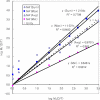The averaging effect of odorant mixing as determined by air dilution sensory tests: a case study on reduced sulfur compounds
- PMID: 22319360
- PMCID: PMC3274054
- DOI: 10.3390/s110201405
The averaging effect of odorant mixing as determined by air dilution sensory tests: a case study on reduced sulfur compounds
Abstract
To learn more about the effects of mixing different odorants, a series of air dilution sensory (ADS) tests were conducted using four reduced sulfur compounds [RSC: hydrogen sulfide (H(2)S), methanethiol (CH(3)SH), dimethylsulfide (DMS), and dimethyldisulfide (DMDS)] at varying concentration levels. The tests were initially conducted by analyzing samples containing single individual RSCs at a wide range of concentrations. The resulting data were then evaluated to define the empirical relationship for each RSC between the dilution-to-threshold (D/T) ratio and odor intensity (OI) scaling. Based on the relationships defined for each individual RSC, the D/T ratios were estimated for a synthetic mixture of four RSCs. The effect of mixing was then examined by assessing the relative contribution of each RSC to those estimates with the aid of the actually measured D/T values. This stepwise test confirmed that the odor intensity of the synthetic mixture is not governed by the common theoretical basis (e.g., rule of additivity, synergism, or a stronger component model) but is best represented by the averaged contribution of all RSC components. The overall results of this study thus suggest that the mixing phenomenon between odorants with similar chemical properties (like RSC family) can be characterized by the averaging effect of all participants.
Keywords: dilution-to-threshold (D/T) ratio; human sensing; hydrogen sulfide; methanethiol; odor mixing; threshold.
Figures



References
-
- Laing D.G., Francis G.W. The capacity of humans to identify odors in mixtures. Physiol. Behav. 1989;46:809–814. - PubMed
-
- Delwiche J.F., Heffelfinger A.L. Cross-modal additivity of taste and smell. J. Sens. Stud. 2005;20:512–525.
-
- Laing D.G., Panhuber H., Slotnick B.M. Odor masking in the rat. Physiol. Behav. 1989;45:689–694. - PubMed
-
- Cometto-Muniz J.E., Cain W.S., Abraham M.H. Dose-addition of individual odorants in the odor detection of binary mixtures. Behav. Brain Res. 2003;138:95–105. - PubMed
Publication types
MeSH terms
Substances
LinkOut - more resources
Full Text Sources
Other Literature Sources

